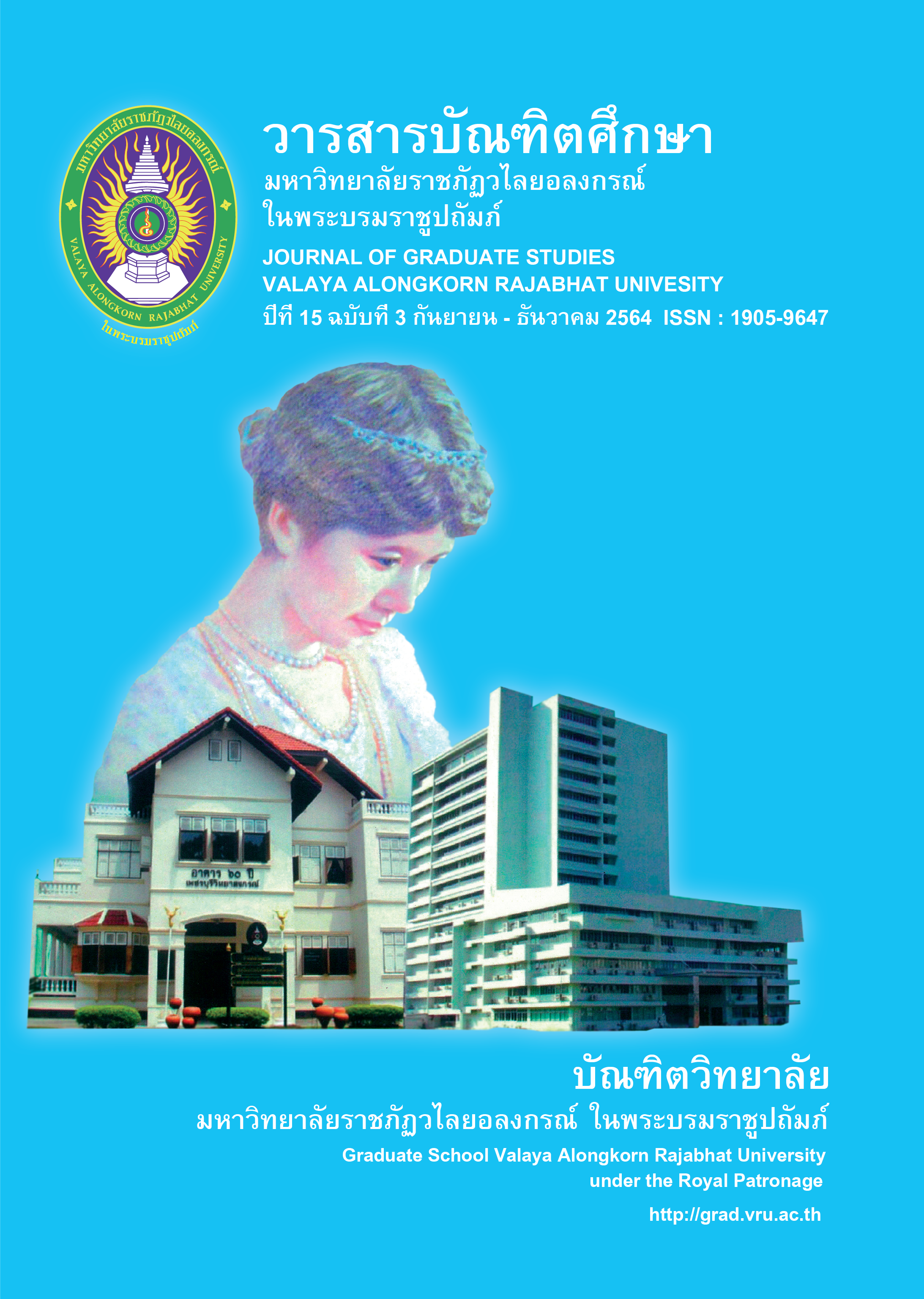THE STUDY OF EDUCATIONAL GAME DESIGN COMPONENTS BY FACTORS ANALYSIS OF PLAYER’S PERCEPTION
Main Article Content
Abstract
Computer game design principles do not have certain rules. Scholars have tried to set the principles and guidelines for designing and developing computer games to be interesting and successful from various criteria. The factors about the feelings of computer gamers can be used to determine the principles of game design. The purpose of this research was to analyze the factors of perception of players towards components of computer games. The data collected from the students who studied in Computer Animation and Game major, the Faculty of Informatics, Mahasarakham University in the academic year 2019, a total of 445 people were randomly sampled 113 people. The rating scale questionnaire titled the perception of the game playing with 35 items which the Cronbach's alpha coefficient was equal to 0.984 were used to data collection. The statistic for analysis was exploratory factor analysis (EFA) with Principal component analysis (PCA) extracting, rotate the orthogonal axis with Varimax. The validation showed that the KMO was 0.779, Bartlett's Test of Sphericity was 6519.945 Sig. 0.000.
The results showed that the extracted components had an Eigen value greater than 1.00, and could explain all variables 79.497%. There are 5 components which are considered as components of computer game design, namely (1) players and players' experience (2) game play feedback (3) attracting players (4) game rules and regulations and (5) challenges and competitions. The results of this research can help computer game manufacturers to use as an important basis in game design and production.
Article Details
บทความทุกเรื่องได้รับการตรวจความถูกต้องทางวิชาการโดยผู้ทรงคุณวุฒิ ทรรศนะและข้อคิดเห็นในบทความวารสารบัณฑิตศึกษา มหาวิทยาลัยราชภัฏวไลยอลงกรณ์ ในพระบรมราชูปถัมภ์ มิใช่เป็นทรรศนะและความคิดของผู้จัดทำจึงมิใช่ความรับผิดชอบของบัณฑิตวิทยาลัย มหาวิทยาลัยราชภัฏวไลยอลงกรณ์ ในพระบรมราชูปถัมภ์ กองบรรณาธิการไม่สงวนสิทธิ์การคัดลอก แต่ให้อ้างอิงแหล่งที่มา
References
Adams, E. (2014). Fundamentals of Game Design. 3rd edition. CA: Pearson Education, Peachpit.
Despain, W. (2013). 100 Principles of Game Design. CA: New Riders.
Jeekatok, K., Butradat, V., and Tongras, S. (2018). kānphatthanā kēm kānsō̜n phư̄a kānrīanrū rư̄ang mư̄prāp khaya samrap rōngrīan prathom sưksā hok [The development Instructional Game with Learning entitled in The Junk Buster for Primary School 6]. Udon Thai Rajabhat University Journal of Science and Technology. 6(1), 137- 149.
Khamoiy, Y. (2013). lakkān ʻō̜k bǣp kēm [Principles of Game Designing]. Retrieved from https://sites.google.com/a/pypw.ac.th/games/bi-ngan-thi-4
Kueachart, P., Jirawatmongkol, S., and Phawaphanankul, C. (2017). nawattakam nǣokhit patčhai thī mī phon tō̜ kānlư̄ak len kēm dičhithankhō̜nthēn thī mī phūying pen phū nam phư̄a khayāi thurakit dičhithankhō̜nthēn [Innovative Factors Concept Affecting Play Choices of Digital Content Game Platform Using Women Characteristic Leading to Expanding Digital Content Business]. Veridian E-Journal, Silpakorn University (Humanities, Social Sciences, and Arts). 10(2), 762 - 772.
Longpradit, P., Khonchoho, P., and Sangthong, C. (2015). kān wikhro̜ læ ʻō̜k bǣp khwāmtō̜ngkān khō̜ng kēm kāntē rī yom khwām phrō̜m rapmư̄ kap sưnāmi phư̄a sanapsanun kānrīanrū dūai theknik kān prap chai fang nathī mī khunnaphāp [Requirements’ Analysis and Design of Tsunami Preparedness Game to Support Learning with a Quality Function Deployment Technique]. Journal of Information Technology Management and Innovation. 2(2), 13 - 21.
Mongkhonsin, K., Suyanang, T., Phakanon, N., Tirakoat, S., and Hiruncharoenvate, C. (2018). phrưttikam kānpœ̄trap læ patčhai thī mī phon tō̜ kātūn ʻǣnimēchan khō̜ng yaowachon [Exposure behaviors and Factors affecting animation cartoon of youth]. Journal of Applied Informatics and Technology. 1(2), 82 - 92.
Nakasan, N., and Nakasan, C. (2016). kēm : nawattakam phư̄a kānsưksā chœ̄ng sāngsan [Game: Innovation for Creative Education]. Rom Phruek Journal Krirk University. 34(3), 159 - 182.
Panking, T., Ratana-o-larn, T., and Petsangsri, S. (2013). kānphatthanā botrīan ʻīlœ̄n ning dōi chai kēm pen thān rư̄ang phangngān [A Development of Game-Based E-Learning Courseware on Flowchart]. Journal of Industrial Education. 14(3), 244 - 251.
Panpumchuen, W. (2014). kān wikhro̜ kānʻō̜kbǣp nithēt sin nai kēm ʻō̜nlai thī prasop khwāmsamret [The analysis of the visual communication design in success online game]. Veridian E-Journal, Silpakorn University (Humanities, Social Sciences, and Arts). 7(2), 1627 - 1647.
Pesopas, T., and Bunlikhitsiri, B. (2015). kānʻō̜kbǣp kēm čhamlō̜ng kānlalēn phư̄nbān Thai tām thritsadī rǣng čhūngčhai [Design of simulation Thai folk game upon incentive theory]. Art and Architecture Journal Naresuan University. 6(2), 90 - 100.
Pinyo, T. (2018). theknik kān tīkhwām phonlap khō̜ng kān wikhro̜ patčhai nai ngānwičhai [Techniques for Interpreting the Results of Factor Analysis in Research Work]. Panyapiwat Journal. 10(Special Issue July 2018), 292 - 304.
Prachumwan, C., and Tirakoat, S. (2013). kānphatthanā kēm khō̜mphiutœ̄ phư̄a songsœ̄m thaksa kān ʻān khō̜ng dek thī mī khwām bokphrō̜ng thāngkān rīanrū [Development of a Computer Game to Promote Reading Skills of Children with Learning Disabilities]. Prae-wa Karasin Journal of Karasin University. 1(2), 91 - 107.
Rouse, R. (2004). Game design: theory & practice. 2nd edition. Taxus: Wordware Publishing.
Saengkrai, P. (2010). sīang læ mantimīdīa [Sound and Multimedia]. Rangsit Music Journal. 5(2 July-December 2010), 38 - 41.
Schell, J. (2008). The Art of Game Design. MA: Morgan Kaufmann Publishers.
Schreiber, I. (2009). Game Design Concepts: an experiment in game design and teaching [Online]. Retrieved from http://gamedesignconcepts.pbworks.com/f/Game+Design+Concepts+0-5.pdf
Sotamaa, O. (2007). Perceptions of Player in Game Design Literature. In Proceedings of DiGRA 2007 Conference: Situated Play. pp. 456 – 465.
Srisa-ard, B. (2013). kānwičhai bư̄angton. 9th edition. Bangkok: Suroyasarn Co., Ltd.
Tangpondparsert, P. (2017). sunsī nai kānʻō̜kbǣp kēm phư̄a sanapsanun kānthō̜ngthīeo ko̜ Rattanakōsin [The Aesthetics in Gamification Design for Supporting Rattanakosin Island Tourism]. Veridian E-Journal, Silpakorn University (Humanities, Social Sciences, and Arts). 10(2), 2883 - 2893.


